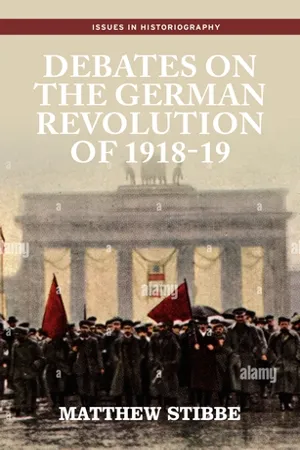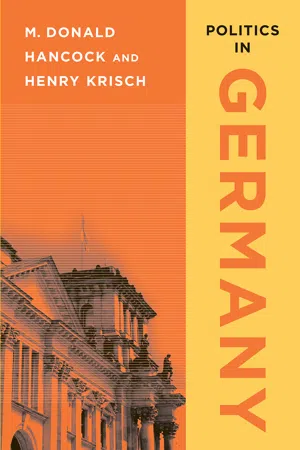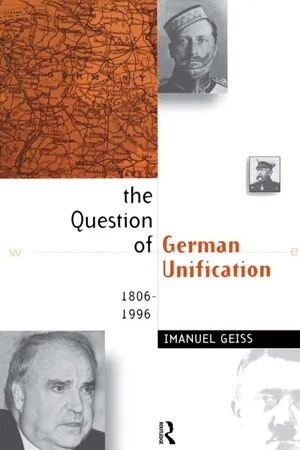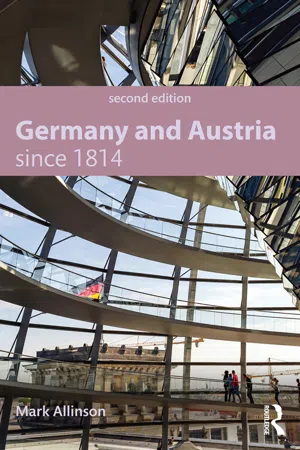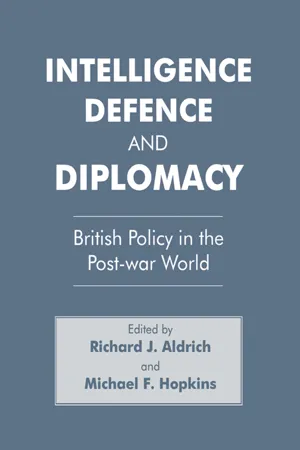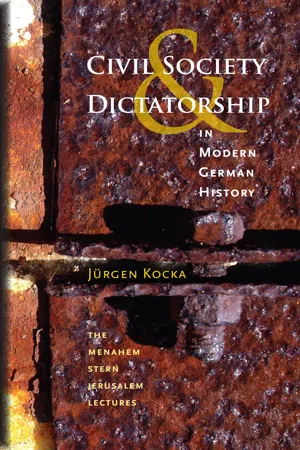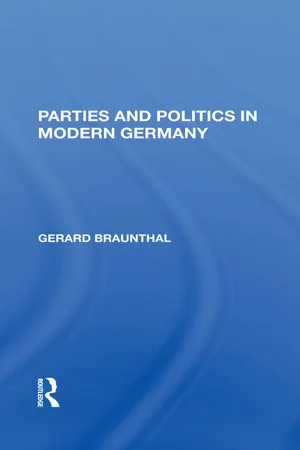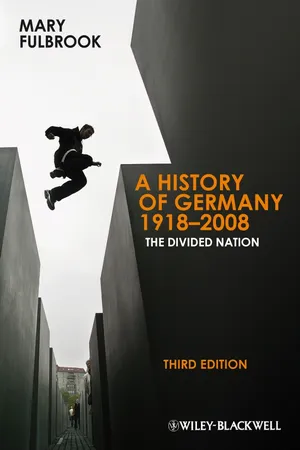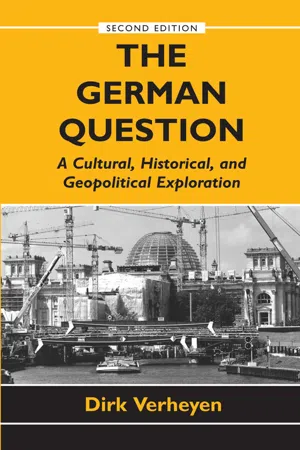History
West Germany
West Germany refers to the western portion of Germany that existed from 1949 to 1990. It was established after World War II and was a democratic state, aligned with the Western bloc during the Cold War. West Germany experienced rapid economic growth and became a key player in European politics and economics before reunification with East Germany in 1990.
Written by Perlego with AI-assistance
Related key terms
Related key terms
1 of 4
Related key terms
1 of 3
11 Key excerpts on "West Germany"
- eBook - ePub
- Matthew Stibbe(Author)
- 2023(Publication Date)
- Manchester University Press(Publisher)
Part II Divided Europe and the politics of history: ‘1918’ in the two GermanysPassage contains an image
3 Revolution betrayed or democracy saved? West German debates, 1949–79The Cold War, which developed apace after 1949, was a truly worldwide phenomenon. Its global reach was underlined by events such as the Korean War of 1950–53, the testing of the first H-bomb in 1952, the Sino-Soviet split from 1960 and the Cuban Missile Crisis of 1962. Nonetheless, it also came to have a special ideological and symbolic significance in central Europe, where two German states – the Federal Republic founded in May 1949 and its Communist rival, the German Democratic Republic, established in October of the same year – stood on what for much of the 1950s and the early 1960s seemed to be the brink of all-out war. From 1955 they were also integrated into rival military alliances – the American-led NATO in the case of the FRG and the Warsaw Pact in the case of the GDR.Just as the German nation was split in half after 1949, so too was the German history profession. However, the timeline for this did not follow the course of the Cold War exactly. In the early 1950s there were still some on both sides who hoped that there was enough common understanding to allow for the maintenance of a single professional body for German historians. The final split came in the mid-to-late 1950s. West Germans such as the conservative Gerhard Ritter, President of the Verband der Historiker Deutschlands (German Historians’ Association (VHD)), refused to accept the new East German journal the Zeitschrift für Geschichtswissenschaft, founded in 1953, as a ‘scientific’ publication, denouncing it as Marxist propaganda. Very few western historians would write for it. Then, at its annual conference in Trier in September 1958, the VHD forbade three East German historians – Ernst Engelberg, Max Steinmetz and Leo Stern – to speak if they appeared as official representatives of the Deutsche Historiker Gesellschaft (German Historians’ Society (DHG)), the new East German body that had been founded a few months before. The DHG ordered a full-scale walk-out, and henceforth instructed all of its members to resign from the VHD.1 Finally, in the run-up to the eleventh International Congress of Historical Sciences in Stockholm in August 1960, Ritter successfully pressed the Swedish organisers not to allow an official delegation from the GDR to attend, insisting that there was only one legitimate body for German historians – the VHD.2 - eBook - ePub
- M. Donald Hancock, Henry Krisch(Authors)
- 2008(Publication Date)
- CQ Press(Publisher)
6 Each postwar German state—the western Federal Republic of Germany and the eastern German Democratic Republic—strove to realize German interests by playing a valued role within its respective alliance. As a result of this territorial segregation of German political forces (conservative and moderate in the West; radical and left-wing in the East), FRG and GDR leaders built polities and societies directly opposed to one another. With the collapse of the Soviet-bloc alliance structure and the dissolution of the GDR, it is the political, economic, and social institutions of the postwar West German republic that shape the unified Germany of today.The Politics of the Two German States
West Germany, under the leadership of Konrad Adenauer, became a state marked by successful integration into a Western alliance structure seen as the surest path to international rehabilitation. The postwar political-social system consisted of a constitutional republic with elaborate safeguards against political subversion and a market economic system coupled with an extensive social welfare network and substantive participation by the state and labor in economic decisions.7 The Federal Republic also served as a founding member of the West European integration process, beginning with the creation of the European Coal and Steel Community in 1951–1952 and continuing with the establishment of a more ambitious European Economic Community (today’s European Union) in 1957–1958. These factors—constitutional democracy, economic liberalism, extensive social provisions, and European integration—have remained to this day both the main pillars of public policy and the broadly accepted popular consensus underlying German political legitimacy.Although the emergent West German state did not abjure the goal of a unified Germany—indeed, the Basic Law proclaimed that it was the task of the “entire German people to achieve the unity and freedom of Germany in free self-determination”—it was clearly meant as a defensive refuge against a perceived Soviet and German Communist threat. West German politics thus consisted of balancing the freedom, social welfare, and Western integration of some three quarters of the total German population against the problematical prospects of national unification. The Federal Republic was at once a bulwark against the East, a refuge for freedom and prosperity, and a self-conscious successor state to past German regimes.8 - eBook - ePub
The Question of German Unification
1806-1996
- Imanuel Geiss, University of Leeds Fred Bridgham(Authors)
- 2013(Publication Date)
- Routledge(Publisher)
Länder, and finally, in 1949, in a Germany which was already divided, at the highest level. The gradual relaxation of control by the occupying powers – in the West more than in the East – was matched by the growth of internal autonomy to near-sovereignty.World-historical context: the Cold War and its conclusion, 1945–1990Inevitably, the democratic western occupying powers and the Stalinist Soviet Union left their mark on their respective occupation zones. But the Soviet Union’s subjection of the peoples of east and south-east Europe to communist rule as new buffer states between Russia and Germany was contrary to what had been agreed. Henceforth, German answers to the chronic German Question were fused into issues connected with the Cold War: with the partition of Europe, the new global structural divide ran through the middle of Germany and Berlin.In the Cold War it was the Germans, on both sides of the Iron Curtain, who were more intensely involved than any other people in divided Europe. They soon rose to become the star pupils of their respective controlling powers, and the next most important players of the two camps. At the same time, the traditional question concerning Germany’s place between East and West took on a new dimension: because it had never been able, for structural reasons, to decide unequivocally between East and West, once Russia assumed a position of hegemony in eastern Europe, Germany was split between the liberal, democratic West and the communist, totalitarian East. Global political rivalry during the Cold War governed the future course of divided Germany.On the other hand, the Cold War was only the most recent example of a situation familiar throughout history: coalitions soon break up after the common enemy has been defeated. The ‘anti-Hitler coalition’ – an emotive term used by communists and their fellow travellers in particular to describe the alliance of opposites formed with this one specific purpose in mind – duly collapsed immediately after the Second World War. There could be no permanent bond, for the belief in democracy which both sides formally professed, in practice meant something very different in either case. For the West, Stalin’s Soviet communism was a real threat to the extent that Stalin was seemingly attempting to keep up the momentum, even beyond the Elbe, of communism’s westward expansion in pursuit of the defeated Third Reich. - eBook - ePub
A History Shared and Divided
East and West Germany since the 1970s
- Frank Bösch(Author)
- 2018(Publication Date)
- Berghahn Books(Publisher)
Third, as a result of the intense rivalry between East and West Germany and the mutual insistence on drawing lines of demarcation, the two states were more closely tied to one another than to other neighboring countries. On the one hand, they were permanently engaged in refuting practices and concepts coming from the other side of the Wall; on the other hand, this rivalry spurred on domestic improvements in each state, be it in terms of social policy or education, sports, or dealing with the Nazi past.Last, given the shared history of Germany since reunification in 1990, it also makes sense to look at the decades beforehand from a shared perspective, not with a focus on 1989, but rather with an eye to the difficulties involved in growing together as one Germany. Such an approach allows for a better understanding of why there are still significant differences between East and West even today. Both Germanys are the divided past of our unified German present.It must be kept in mind, however, that many things were different in East and West, even if they shared the same name. A political party or trade union in the West was fundamentally different from a political party or trade union in the East. Likewise, the search for transfers and entanglements bears the risk of overinterpreting the relevance of individual contacts, interactions, or mutual observations—a danger that is inherent to transnational history in general. Moreover, the creation of a new teleological master narrative leading up to 1989 has to be avoided.62 Not only do historians need to explain the downfall of the GDR, but also they have to account for its long-lasting stability, which made even West German experts think that reunification was not on the horizon in early 1989. And, finally, it cannot be assumed too rashly that a sense of national unity or a shared German identity in both states justifies a joint perspective in and of itself. Even within the GDR, a feeling of “we” evolved that did not necessarily correspond to the “socialist nation.”63 Too little attention has been paid up to now on how the concept of the “nation” developed within the context of divided Germany and how stronger supranational identities were built before and after unification.64 - eBook - ePub
- Mark Allinson(Author)
- 2014(Publication Date)
- Routledge(Publisher)
6 Rehabilitation, restoration and reform West Germany, 1949–89 DOI: 10.4324/9780203784938-6Timeline23 May 1949 Grundgesetz comes into force 15 September 1949 Konrad Adenauer elected Bundeskanzler 9 May 1955 The Bundesrepublik joins NATO as a sovereign state 1 January 1957 Saarland joins the Bundesrepublik 26 October 1962 ‘Spiegel-Affäre’ begins 15 October 1963 Adenauer retires as Bundeskanzler 1 December 1966 groβe Koalition takes office April 1968 Mass demonstrations; shooting of Rudi Dutschke (11 April) 21 October 1969 Willy Brandt (SPD) elected Bundeskanzler 1977 Peak of left-wing terrorist movement 12–13 January 1980 Green Party founded 1 October 1982 Helmut Kohl (CDU) elected Bundeskanzler The rivalries which had sparked two world wars inspired western European politicians to unite the different states in a common interest after 1945. The Cold War, which overshadowed this period, prevented a pan-European settlement, but in 1949 gave rise to a western military alliance, NATO (North Atlantic Treaty Organisation), including the United States and Canada. Joint institutions also countered economic rivalries: the multinational common market for coal and steel (Montanunion) of 1951 expanded into the European Economic Community (EEC) in 1958. By 1989 the renamed European Community’s (EC) twelve member states shared political, cultural and legal norms, and were building an open market for goods and services. A new political consensus also favoured unity: once Spain and Portugal had removed right-wing dictatorships in the mid-1970s, all western Europe was characterised by stable democracies. The period saw unprecedented economic prosperity, and accompanying environmental damage.Structures of the Bundesrepublik
None of the German states, and none of the chronological periods we have discussed so far, has been characterised by stability. At least with the benefit of hindsight, each of the pre-1949 regimes seemed to contain the seeds of their own destruction. Even Bismarck’s Reich - eBook - ePub
Intelligence, Defence and Diplomacy
British Policy in the Post-War World
- Richard J. Aldrich, Michael F. Hopkins(Authors)
- 2013(Publication Date)
- Routledge(Publisher)
3 Reunification or Integration with the West? Britain and the Federal Republic of Germany in the early 1950s Klaus LarresDOI: 10.4324/9781315035925-3The period between the fall of the Berlin Wall in November 1989 and the merging of East and West Germany on 3 October 1990 was marked by worries and the concern of many people that a unification of the two Germanies would destabilize Europe.1 It was alleged that a united Germany with a population of almost 80 million would soon become a new economic superpower and once again an arrogant political giant on the international scene.2 Only very few people believed that the four victorious powers of the Second World War were genuine and unequivocal supporters of the creation of a unified German state. However, developments in Eastern Europe in 1989–90 seemed to make German unification inevitable. Britain, France, the United States and the Soviet Union now had to stand by their many promises to the German people during the previous 45 years and convert these pledges into reality.In the 1950s, when the international scene was still very fluid and the modus vivendi of the Cold War not yet fully accepted, politicians in East and West also kept professing that they were seriously interested in overcoming the partition of Germany as soon as possible.3 Why, then, did it never materialize? After all, politicians and the military in the early 1950s genuinely believed that a permanent division of Germany would soon lead to turmoil and war. Based on the convictions as expressed at the Potsdam Conference in 1945, they thought that only a united Germany would guarantee a peaceful and economically healthy Europe. Otherwise it was assumed the German people would soon create so much trouble in order to obtain unity and prosperity that the stability of Europe and the world would be seriously endangered.4 This attitude began to change with the gradual Western realization that not only Chancellor Adenauer but above all the West German people, the huge majority of the German population, were not really very much interested in getting the country reunified. Despite the popularity of the unification issue in opinion polls and ‘the simmering discontent with the division of Germany’,5 the West Germans were apparently much more concerned with rebuilding their own careers and enjoying the fruits of the burgeoning economic miracle than with the fate of their brethren in the East. The High Commissioner in Bonn even claimed that the Germans were mainly interested in the ‘three Bs’ – belly, BMW and building society account.6 - Jürgen Kocka(Author)
- 2012(Publication Date)
- Brandeis University Press(Publisher)
IV Dealing with Difficult Pasts: Collective Memories and Politics in Germany after 1945 and 1990T he two German states, the Federal Republic of Germany (FRG ) in the West and the German Democratic Republic (GDR ) in the East, were strikingly different: one with a market economy, a pluralist society, a parliamentary democracy, very much part of the Western camp under the leadership of the United States; the other with a state-socialist economy, a thinly disguised one-party dictatorship with Marxism-Leninism as an obligatory state ideology, very much part of the Eastern bloc under Soviet hegemony.1 But the two states also had some things in common, for example a common past. Both were postfascist systems. How did they relate to their National Socialist past? — Nazi Germany and the GDR were very different, but one can see them as the two German dictatorships of the twentieth century.2 From this perspective, it becomes interesting to study in a comparative way how the two systems were remembered and dealt with after they ended: Nazi-Germany after 1945 and the GDR after 1990. Comparing, of course, means looking for similarities and differences. Usually, historians find differences more interesting.3First I shall discuss how West Germans and East Germans dealt with their fascist past between 1945 and 1989. Then I shall compare the post-1989/90 memories and remembrance strategies with the post-1945 ones. I shall end with some remarks on the situation today and offer some general conclusions.How West Germans and East Germans Dealt with Their Nazi Past , 1945–1990When the Westphalian Peace Treaty brought the Thirty Years War to an end in 1648, it prescribed what many political settlements have stipulated before and thereafter: eternal forgetting and amnesty for all the offenses, cruelties, and crimes committed during the previous war. It was forbidden to debate them in public, for fear that they would create new tensions and conflicts.4- eBook - ePub
- Gerard Braunthal(Author)
- 2019(Publication Date)
- Routledge(Publisher)
Part Two West German Parties Since World War IIPassage contains an image
3 The Party State: Political LegitimacyTHE POLITICAL LEGITIMACY of parties in various political systems varies considerably. In Germany, as we have seen, parties were fully accepted during the Weimar era, only partly during the Empire era, and not at all, except for the NSDAP, during the Nazi era. The end of Nazism gave Germans in the three western occupation zones a new chance, under the tutelage of the Western Allies, to build sound democratic institutions that would lay the foundations for a "party state." In a party state, strong democratic parties are an integral part of the political system. They compete against each other to gain political power and guide the nations destiny. They also seek to dominate other key institutions, such as the bureaucracy, the judiciary, and the media, to maximize power.1 However, when parties fail to address crucial economic and social problems affecting citizens or become involved in financial scandals, disenchantment with them sets in, which has been the case in Germany since the late 1980s.This chapter examines key factors of the party state: the rebirth of the pluralist party system in western Germany in 1945, the constitutional founda tion of the West German parties, the funds given the parties, and the electoral system that affected the party configuration. A survey of these factors should help determine whether the rise of the party state contributed to the development of a stable democratic system and a politic al culture that made citizens more tolerant of and sympathetic to parties than in earlier periods of German history.Rebirth of a Pluralist Party System
May 1945 marked the collapse of the Nazi regime. In western Germany, Allied representatives insisted that a democratic system be created, initially at the local level. To work with them in the three occupation zones, these representatives chose both German anti-Nazi leaders and officials who had served under the Hitler regime but had been denazified. The latter were imbued with the values of democracy that had already flourished during the Weimar period. - eBook - ePub
A History of Germany 1918 - 2008
The Divided Nation
- Mary Fulbrook(Author)
- 2011(Publication Date)
- Wiley-Blackwell(Publisher)
all joint stock companies with over two thousand employees.) In 1952 the Works Constitution Law provided that there should be works councils for enterprises with more than twenty employees. West Germany had a relatively low strike record. It also uniquely benefited, in the first decade or so after its foundation, from a supply of cheap and mobile labour: the refugees from the German Democratic Republic. Initially these people represented a burden of extra bodies to be housed and fed; and in 1950 the unemployment rate stood at 8.1 per cent. But the rapidly expanding economy was soon able to absorb them (with early help from the Korean War boom), and by the mid-1960s the unemployment rate stood at a mere 0.5 per cent. During the 1950s around three million people fled from the East, and a large proportion of these were young, skilled people in search of better career prospects than they could find in East Germany. Many of the attempts by the Allies to restructure and decentralize the economy were successfully resisted by West German industrialists: there was fairly rapid reconcentration and recentralization, and the revised Law on Decartelization which was passed after many amendments in 1957 left sufficient loopholes as to be little impediment to West German industrialists.Whatever the reasons, in the course of the 1950s West Germany was becoming a prosperous society. By the later 1950s writers such as Heinrich Böll were beginning to pour scorn on what they saw as a bourgeois, self-satisfied materialism which lived only for current comforts and suppressed the past; but rapid economic success was certainly a powerful factor in ensuring the early commitment of vast numbers of formerly undemocratic Germans to the new democracy which had been in large measure thrust upon them in an hour of national humiliation and defeat. The contrast to the early years of Weimar democracy is striking.Despite the relative lack of positive ideological commitment to democracy, there was nevertheless a powerful transitional ideology in the 1950s: that of anti-communism. Anti-communism had long been a prevalent orientation among the German middle classes, and it had played an important role in the rise of Hitler. It was not something new which had to be inculcated in the Germans by foreign powers. Yet it took on new flavours during the Cold War, and was stimulated by the anti-communism in particular of the Americans. Fear of the ‘bolshevist threat’ provided powerful support for Adenauer’s policies of western integration, outweighing the natural desire of most Germans to see their country reunified. At the same time, the example of Marxist-Leninist practice in the East was used to cast aspersions on the West German SPD, which, despite its constant and genuine avowal of commitment to democracy, was adversely affected by slur campaigns from the right. - eBook - ePub
- Dirk Verheyen(Author)
- 2018(Publication Date)
- Routledge(Publisher)
West Germany’s identity came to depend a great deal on the country’s membership in and acceptance by the Western alliance and the general community of Western nations. The fear of being the ultimate victim of an East-West political and military bargain (a “Potsdam complex”) produced a persistent strain of anxiety and insecurity, thereby heightening the uncertainties of identity. For much of the postwar period, it seemed that the Federal Republic’s participation in the process of European integration would provide it with an ersatz European identity. Many Germans eagerly supported this hopeful opportunity. As the expectation of a soon-to-be-united Europe faded in the course of the 1960s and 1970s, however, and nationalist sentiments in Europe appeared to remain more influential than expected, the Federal Republic’s identity problems returned. It is possible to argue, then, that West Germany’s identity over the years involved an attempt to focus on both the democratic values shared with the West and the sense of Germanness shared with East Germany. The Third Reich helped discredit nationalism as an ideology, particularly in its more virulent and extremist form. The Federal Republic sought to develop a sense of identity that would overcome the illiberal legacies of the past. Yet all this did not mean that all nationalist sentiment had disappeared in West Germany. 85 As was the case after World War I, the resurgence of nationalism as a reaction to defeat could not be ruled out in the early post-World War II period. The trauma of national division could only add to this potential ideological powder keg. The shock of Nazism and the totality of defeat seemed to have been sufficiently great to forestall any full-scale nationalist revival, however. More problematic was the fact that Cold War anti-Communism had an apparent and awkward affinity with the anti-Bolshevism that had played such a prominent role in the extremist nationalism of the interwar period - eBook - ePub
Old Nations, New World
Conceptions Of World Order
- David Jacobson(Author)
- 2019(Publication Date)
- Routledge(Publisher)
Bundesbank experts not to adopt a 1:1 rate of exchange for East German currency The economic factor may further explain Soviet reluctance at the time to sustain the East German regime, since Moscow had its own high hopes under Gorbachev in regard to Western economic ties. To this, and to the ensuing collapse of the Soviet Union itself, we shall return later. In fact no one expected such a rapid German political union. Most experts believed that the transition period toward complete unification would be lengthy, again the wrong conclusion for the right reasons, i.e., the recognition of the economic difficulties inherent in too-rapid a unification process and the recognition of East Germany’s separate history. This history could hardly sustain the old guard regime; yet while the country became open to important inputs from the West it did not seem ready to renounce entirely its socialist aspirations and state protection. Nor did anyone expect the collapse of the Soviet Union itself.Chancellor Helmut Kohl and his former Foreign Minister Hans-Dietrich Genscher were driven by a sense of urgency, fearing that Soviet or East German forces might stop unification. Thus they pushed even harder, by invoking economic hopes that supported national-political aspirations. Weidenfeld and Korte suggest that unification may help in transforming Germany from a divided nation that had problems of identity connected to the Nazi heritage to a fully normal one, that is now more capable of engaging in the supranational, European future.26 Their argument is formulated cautiously, but confidently. We, on the other hand, are interested here in a short discussion of the unification process and its re-suits in concrete terms.First, the Nazi past was not fully ignored, and thus history still played a role in the unification process and the ensuing treaties that crowned it: The borders of the united Germany were determined by WWII, and finally recognized by the Federal Government as such. The departure of about 15 million Germans from their ancient homeland, which was absorbed into either Poland or Russia (even today when former East Prussia is cut off from Moscow by several independent states, and Koenigsberg-Kaliningrad has been recently envisioned as a free “European” trade center), seems to be an accomplished, even forgotten, fact.Second, united Germany, even if officially proclaimed to be “sovereign” by the former WWII Allies, continues to accept sovereignty limitations. The Bundeswehr
Index pages curate the most relevant extracts from our library of academic textbooks. They’ve been created using an in-house natural language model (NLM), each adding context and meaning to key research topics.
Explore more topic indexes
Explore more topic indexes
1 of 6
Explore more topic indexes
1 of 4
